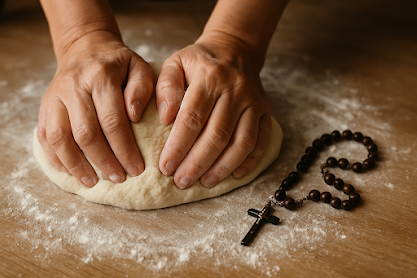There’s a kind of beauty to beginning.
The spark of conversion. The moment grace breaks in. The first time the Gospel feels personal and electrifying.
But beginnings aren’t everything.
In fact, some of the most powerful, fruitful Catholics I know had very quiet beginnings—or none at all. Their faith wasn’t marked by a grand gesture. It was shaped by what they chose to keep doing, day after day, year after year.
The difference between faith that starts and faith that stays isn’t intensity.
It’s rootedness.
Sparks Fade. Roots Hold.
The early passion is good. It’s real. But it’s also designed to shift.
You aren’t meant to feel the same kind of spiritual rush forever.
God matures us through rhythms, not fireworks.
That’s why the Church doesn’t just celebrate feasts—she teaches us how to fast. She doesn’t just preach big emotions; she teaches us to pray the Liturgy of the Hours when we’re tired. She hands us seasons, sacraments, and silence.
Faith that stays is sacramental, not sentimental.
It doesn’t depend on a mood. It depends on a Person.
The Catechism of the Catholic Church affirms this deeply: “Faith is a personal act—the free response of the human person to the initiative of God who reveals himself” (CCC 166). It is not a one-time burst. It is a lifetime response.
What Staying Faith Looks Like
It shows up at Mass even when the homily is dry.
It prays a short psalm instead of nothing at all.
It goes to Confession after one bad week—or ten.
It starts again. And again. And again.
Staying faith is ordinary.
And that’s what makes it extraordinary.
Because while everyone loves a mountaintop moment, it’s the habit of returning that forms the soul.
Jesus Himself modeled this. Luke 5:16 tells us, “He would withdraw to deserted places and pray.” Not once. Not dramatically. But often. Quietly. Faithfully.
We are invited into that same rhythm.
Faith That Stays Is Relational
Staying faith doesn’t mean blind obedience.
It means trusting the One you’ve come to know.
Not as a concept. Not as a checklist. But as a Person.
When you really know someone, you don’t need constant fireworks to stay close. You share life. You listen. You wait. You walk.
God wants that kind of relationship with you.
The Church, in her rhythms and sacraments, is how He sustains it.
The Eucharist is the perfect example. Not a once-in-a-lifetime miracle, but a daily invitation. A steady presence. A place to return and receive.
The Catechism puts it plainly: “The Eucharist is the source and summit of the Christian life” (CCC 1324). Not just its high point, but its center of gravity.
So if you don’t feel the spark? If you feel like your faith has settled into something quieter?
That’s not failure.
That’s fidelity.
Why Emotional Experience Isn’t the Goal
There’s nothing wrong with feeling close to God. In fact, those consolations can be a gift. But emotional depth isn’t the measure of your holiness.
St. John of the Cross, St. Teresa of Avila, and even Mother Teresa went through seasons of dryness, sometimes for years. Their faith didn’t fade because their feelings did. Their faith endured because they stayed.
The saints weren’t sustained by enthusiasm. They were sustained by trust.
Faith isn’t about chasing the next spiritual high. It’s about building a life that keeps showing up for God, even when your heart feels quiet.
Faith and Formation Go Hand in Hand
One of the most important things we can do for staying faith is pursue formation. That means understanding not only what the Church teaches, but why.
When we study the Catechism, sacred scripture, the lives of the saints, and the writings of the Church Fathers, we’re giving our faith deep roots. Jesus told us in Matthew 7:24 that “Everyone who hears these words of mine and acts on them will be like a wise man who built his house on rock.”
Faith that stays is built on rock, not sand.
And that rock is truth.
Final Thought: You Are Not Alone in This
If your faith has gotten quieter lately, you are not less holy.
If you’ve grown less emotional but more committed, you are not drifting, you are deepening.
If you don’t know what to pray, but you still show up, that’s a kind of worship too.
St. Paul reminds us in 2 Timothy 4:7, “I have fought the good fight, I have finished the race, I have kept the faith.” Not because he always felt great. But because he endured.
Faith that starts is a grace.
Faith that stays is a witness.
Love this reflection? Support more faith-rooted content and get exclusive downloads at ko-fi.com/convertingtohope.

.png)
.png)









.png)


.png)
.png)
.png)
.png)
.png)
.png)
